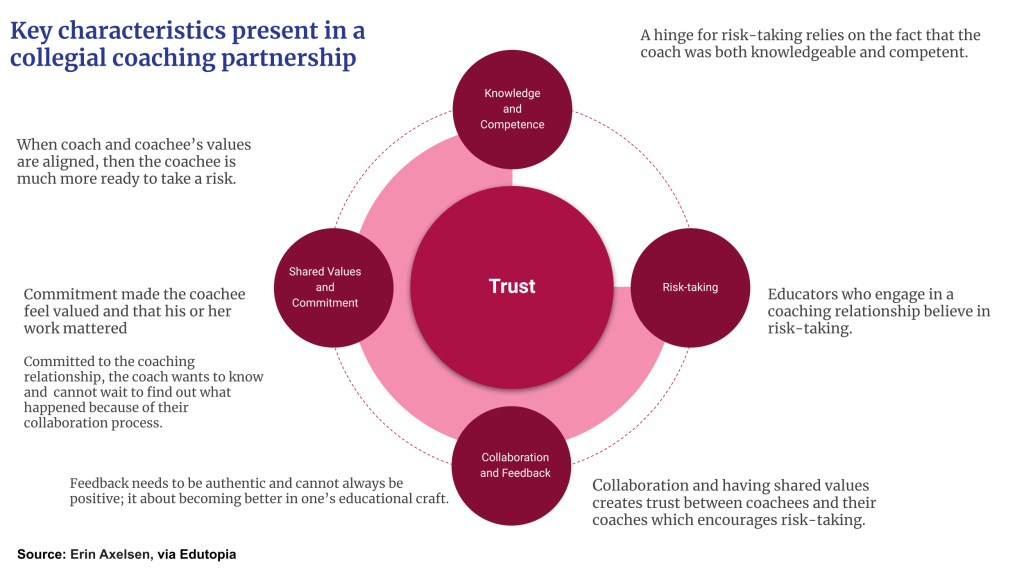Collegial Coaching for Mutual Benefit
With this coaching relationship, hierarchy doesn’t matter—it’s all about school leader colleagues supporting each other for professional growth.
Your content has been saved!
Go to My Saved Content.School leadership is challenging. As the complexity and the demands on school administrators grow, leading a school can be an isolating job at times. Navigating staff and student issues, assessment pressures, and community expectations while maintaining a healthy social and emotional school culture are just a few of the challenges that school leaders face.
To support our school leaders, districts need to encourage and facilitate opportunities for them to participate in a collegial coaching partnership. The issues they encounter are too large and complex for any individual school leader to navigate and solve alone.
How collegial coaching is different
Collegial coaching is a peer-based relationship in which school leader colleagues work together for a specific, predetermined purpose: to support their professional growth. What’s new about this model is that it creates coaching partnerships that are mixed-role and mixed-district in nature. Coaching partnerships are made up of mixed pairings from school district roles such as assistant superintendent, principal, assistant principal, district director, instructional coordinator/innovator, and department chair.
The level of expertise among both the coach and the coachee doesn’t create a hierarchical relationship in which the coach is viewed as more advanced in their leadership skills compared with the coachee. For example, one current partnership consists of an assistant principal whose coaching partner is an assistant superintendent.
From a title perspective, it would appear that there’s a hierarchy, so that the assistant superintendent is “coaching” the assistant principal. This isn’t the case, though, as both partners may switch roles and/or work together within the coaching partnership to coach one another on particular goals or issues.
For instance, within this partnership, they’ve shared resources and tackled building district programming for multilingual learners, along with advancing equity work within their districts. Throughout this work, they both move in and out of the coach and coachee roles based on their experience and level of expertise with their coaching focus.
For these types of partnerships, being grounded in the same values, building trust, and asking effective questions are just a few of the characteristics that make coaching relationships strong. School leaders voluntarily participate; it’s not a district requirement or expectation. At its core are educators who are committed to their partnership to achieve their goals and grow professionally.
How school districts can get started
School districts can take an active part in fostering and supporting collegial coaching partnerships by creating networks that provide their leaders with coaching opportunities within their district, in neighboring districts, or in partnerships with other organizations in the region, such as the state principal association affiliate or, in my area, the Midwest Principals’ Center. Creating a time and space for leaders to come together to collaborate and learn from others in their field and supporting them through their leadership growth and challenges is a game changer.
Establishing networks and providing meeting opportunities gives leaders the chance to get to know other leaders in their area and form partnerships not controlled by district or building administrators. Choice makes all the difference. The partnership between the assistant principal and assistant superintendent, for example, is successful because they share common values, objectives, leadership styles and personality traits. They’re a good fit and feel safe being vulnerable with one another, in part because they chose to be partners.
Choice fosters genuine collaboration on a whole host of issues. Within these partnerships, school leaders support one another on pressing issues of the day, such as best practices in instruction and assessment. From a social and emotional (SEL) standpoint, they’re brainstorming ways to show genuine appreciation to their staff for the difficult work they do and creating programs to assist their students who are in need of SEL support and services. Their coaching time is beneficial, as it lightens the load, and they don’t have to come up with all the answers alone. They’re able to share their challenges and become more effective.
The benefits of a collegial coaching relationship
What makes this model so effective is that it benefits both collegial coaching partners. The relationship supports the accomplishment of professional growth goals, positively impacts decision-making to benefit districts and schools, and enriches relationships that foster the development of school leaders to build capacity in their own organizations.
No issue is off-limits in these partnerships, which was on full display throughout the pandemic. When education saw its entire teaching and learning model turned on its head, these coaching relationships provided support and collaboration to deal with the federal, state, and local issues caused by Covid-19. School leaders supported their coaching partners on ways to organize building spaces, bus routes, and classrooms that adhered to mandates. They collaborated on how to create hybrid learning schedules and co-created professional development sessions to support teachers with the ever-changing classroom dynamic.
Since the pandemic began, school leaders have been collaborating on ways to accelerate student learning by working with each other on ways to leverage summer learning options to support students. They’re sharing ideas, resources, and program highlights on how to reengage and motivate students in their learning, whether that be through cooperative learning or other engagement strategies.
Their coaching relationships ultimately helped them with their building and district challenges then, and they continue to provide support as education moves into a post-pandemic stage. All of this was and is possible because this type of coaching relationship fosters key characteristics that make it successful.
The graphic below highlights the key characteristics present in this partnership and speaks to its strength as a coaching model.

